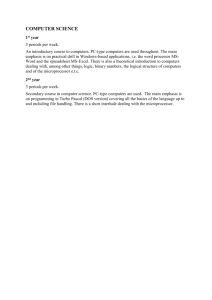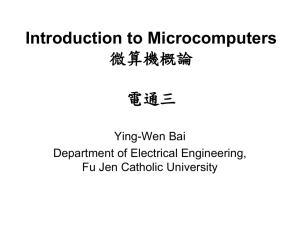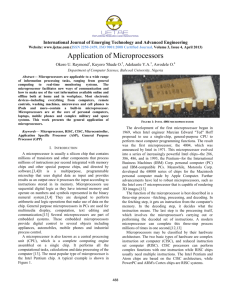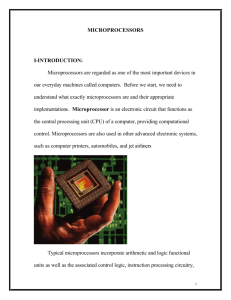Digital electronics microprocessors and computers
advertisement
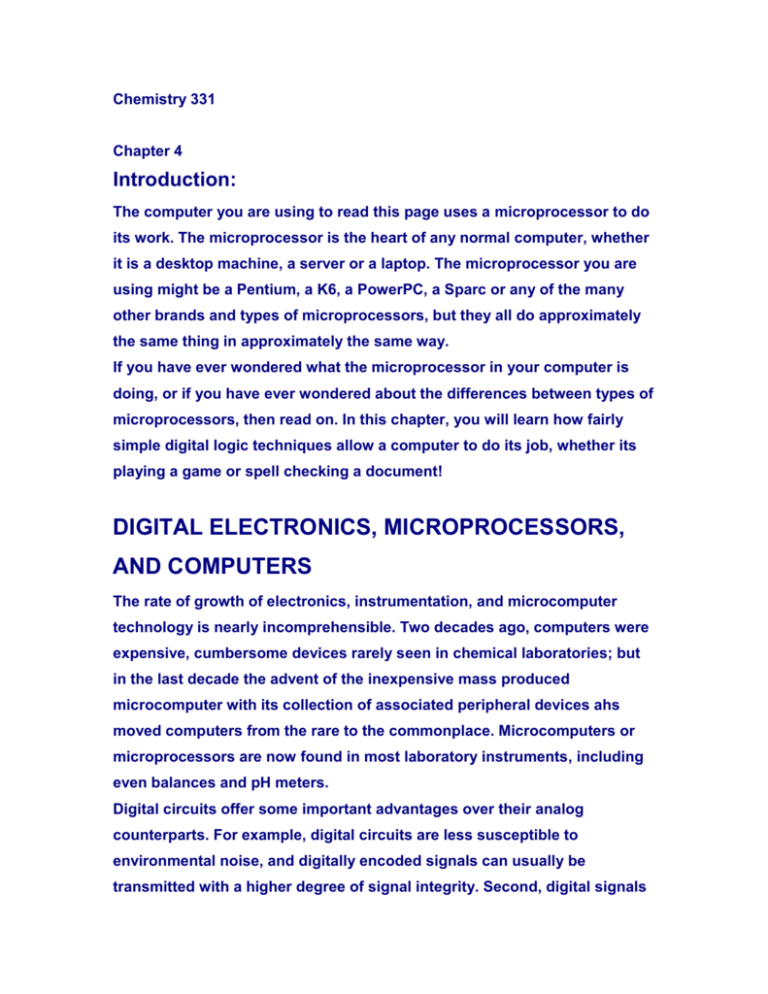
Chemistry 331 Chapter 4 Introduction: The computer you are using to read this page uses a microprocessor to do its work. The microprocessor is the heart of any normal computer, whether it is a desktop machine, a server or a laptop. The microprocessor you are using might be a Pentium, a K6, a PowerPC, a Sparc or any of the many other brands and types of microprocessors, but they all do approximately the same thing in approximately the same way. If you have ever wondered what the microprocessor in your computer is doing, or if you have ever wondered about the differences between types of microprocessors, then read on. In this chapter, you will learn how fairly simple digital logic techniques allow a computer to do its job, whether its playing a game or spell checking a document! DIGITAL ELECTRONICS, MICROPROCESSORS, AND COMPUTERS The rate of growth of electronics, instrumentation, and microcomputer technology is nearly incomprehensible. Two decades ago, computers were expensive, cumbersome devices rarely seen in chemical laboratories; but in the last decade the advent of the inexpensive mass produced microcomputer with its collection of associated peripheral devices ahs moved computers from the rare to the commonplace. Microcomputers or microprocessors are now found in most laboratory instruments, including even balances and pH meters. Digital circuits offer some important advantages over their analog counterparts. For example, digital circuits are less susceptible to environmental noise, and digitally encoded signals can usually be transmitted with a higher degree of signal integrity. Second, digital signals may be transmitted directly to digital computers, which means that software can be used to extract the information from signal outputs of chemical instruments. Microprocessor History A microprocessor -- also known as a CPU or central processing unit -- is a complete computation engine that is fabricated on a single chip. The first microprocessor was the Intel 4004, introduced in 1971. The 4004 was not very powerful -- all it could do was add and subtract, and it could only do that 4 bits at a Intel 4004 chip time. But it was amazing that everything was on one chip. Prior to the 4004, engineers built computers either from collections of chips or from discrete components (transistors wired one at a time). The 4004 powered one of the first portable electronic calculators. The first microprocessor to make it into a home computer was the Intel 8080, a complete 8-bit computer on one chip, introduced in 1974. The first microprocessor to make a real splash in the market was the Intel 8088, introduced in 1979 and incorporated into the IBM PC (which first appeared Intel 8080 around 1982). If you are familiar with the PC market and its history, you know that the PC market moved from the 8088 to the 80286 to the 80386 to the 80486 to the Pentium to the Pentium II to the Pentium III to the Pentium 4. All of these microprocessors are made by Intel and all of them are improvements on the basic design of the 8088. Analog and Digital Signals Chemical signals are of two types, digital and analog. An example of a digital, or discrete, chemical signal is the radiant energy produced by the decay of a radioactive species. Here, the signal consists of a series of pulses of energy produced as individuals atoms decay. These pulses can be converted to electrical pulses and counted. The resulting information can be expressed as an integer number of decays, which is one form of information. The form that the signal takes depends on how one looks at the signal. For example, the yellow radiation by heating sodium ions in a flame is often measured with a photo-detector that converts radiant energy into an analog current, which can vary continuously over a considerable range. However, at low radiation intensity, a properly designed detector can respond to the individual photons, producing a signal that consists of a series of pulses that can be measured.(see figure 1.) In modern instruments, an analog signal such as shown in figure l(a), is converted to a digital one, figure l(b), by sampling and recording the analog output at regular time intervals. Arithmetic With Binary Numbers In typical digital measurement, a high-speed electronic counter is used to count the number of pulses that occur within a specified set of boundary conditions. Examples of signals and boundary conditions include number of photons or alpha decay particles emitted by an analyte per second or the number of drops of titrant per millimole of analyte. Counting such signals electronically requires that they first be transduced to provide a series of pulses of more or less equal voltage. Ultimately, these pulses are converted by the counter to a decimal number of a display. It turns out, however, that the decimal system from representing numbers is not a convenient one to use in the counting operation, because this system requires ten different electrical signals to represent the digits 0 to 9. For this reason, electronic counting is performed by binary numbers; here, only two digits, 0 and 1, are required to represent any number. The following diagram shows an extremely simple microprocessor capable of doing those three things: This is about as simple as a microprocessor gets. This microprocessor has: An address bus (that may be 8, 16 or 32 bits wide) that sends an address to memory A data bus (that may be 8, 16 or 32 bits wide) that can send data to memory or receive data from memory An RD (read) and WR (write) line to tell the memory whether it wants to set or get the addressed location A clock line that lets a clock pulse sequence the processor A reset line that resets the program counter to zero (or whatever) and restarts execution Relationship Between Decimal and Binary Decimal Number Binary Representation 0 0 1 1 2 10 3 11 5 101 12 1100 32 100000 64 1000000 Basic Digital Components An instrument for counting the number of electrical pulses from a transducer per unit time consists of the following components: 1) Signal Shapers: This is essentially an operational amplifier that makes use of a voltage comparator to convert the signal to the square wave form(figure 2) 2) Binary Counter: Electronic counters employ a series of binary circuits( or binaries) to electrical pulses. These circuits are basically electronic switches that have two logic states, on/l and off/0. Each binary circuit can the be used to represent one digit of a binary number(or the coefficient of a power of two) a convenient binary circuits for counting is the so-called flip-flop. A flipflop is a device that alternates between two output signals(O and 1) depending upon the input signal. The major uses for flip-flops are as counters and as memory units, i.e., as devices that are used to store an input signal. 3) Binary Coded Decimal System: This is the system that converts from binary to decimal numbers. 4) Scalers: The process of reducing a count by a known fraction is called scaling, and becomes important when the frequency of a signal is greater than the counting device can accommodate. In this situation, a scaler is introduced between the signal source and the counter. 5) Clocks: Many digital applications require a highly reproducible and accurately known frequency source to be used in conjunction with the measurement of time. Generally, these frequency sources are based upon quartz crystals. 6) Digital to Analog Converters: Digital signals are often converted to their analog counterparts for the control of instruments or for display by readout devices such as meters and analog recorders. One common method is to use a circuit similar to a summing circuit of an operational amplifier (figure 4). Microprocessors and Microcomputers A microprocessor is a large-scale integrated circuit made up of tens and even hundreds of thousands of transistors, resistors, switches, and other circuit elements miniaturized to fit on a single silicon chip. A microcomputer is made up of one or more microprocessors combined with other circuit components that provide memory storage, timing, input and output functions. Microcomputers are finding an ever-increasing use in controlling analytical instruments and in processing, storing, and displaying the data derived from them. Among the reasons for connecting the computer to an analytical instrument is that partial or complete automation of measurements become possible. Ordinarily, automation leads to more rapid data acquisition, which shortens the time required for analysis or increases precision by providing time for additional replicate measurements to be made. Also, automation provides better control over experimental variables than a human operator can achieve. Applications of Computers Computer interactions with analytical instruments are of two types, passive and active. A) Active Applications: In this type of application only part of the computers time is devoted to data collection, the rest being used for data processing and control. Thus active applications are real-time operations. An example of an active application would be to use one or more microprocessors to perform a control function such as, the rate of addition of a reagent. Because of its great speed, the computer can often control variables more efficiently than can a human operator. Furthermore, with some experiments, computers can be programmed to alter the way in which a measurement is be made, according to the nature of the initial data. B) Passive Applications: In this type of application, computers are mainly used to store and process data. The main difference between these two types of operations is that in passive applications, the computer does not help control variables in the experiments. Computer Networks The connection of two or more computers produces a computer network. To the chemist computer networks can be divided into two basic networks, national and international networks and local area networks(LAN). These networks facilitate the rapid transmission of information from one place to another. It is common to find virtually all information about samples or research projects is handled through the LAN in industrial setting. The efficient of LANs requires that they be specifically designed to meet the needs of a particular lab. REFERENCES: http://192.215.107.101/ebn/942/tech/techfocus/1071main.html http://www.chem.usu.edu/~sbialk/Classes/565/opamps/opamps.html Skoog, Holler, and Neiman. Principles of Instrumental Analysis. 5th ed. Orlando: Harcourt Brace & Co., 1998.



